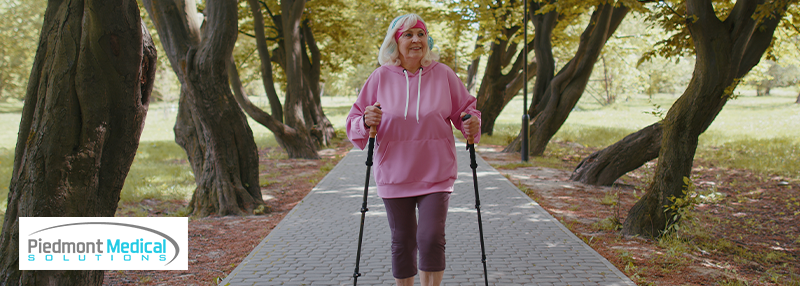Piedmont Medical Solutions
Updated Mon August 18, 2025
Published Under: Urological

Urinary incontinence can be a frustrating and even isolating condition, but you are far from alone. It affects millions of people of all ages and backgrounds, and the good news is: it’s manageable.
Whether you’re newly experiencing symptoms or helping a loved one through it, this guide will walk you through the causes, types, and treatment options for urinary incontinence, and how Piedmont Medical Solutions can support you with the right supplies and guidance.
What Is Urinary Incontinence?
Urinary incontinence is the involuntary leakage of urine. It can range from occasional dribbles during a laugh or sneeze to a complete loss of bladder control. While it’s more common with age, it’s not an inevitable part of aging and treatment is available.
Common Causes of Urinary Incontinence
There’s no single cause of incontinence; it often results from a combination of physical, neurological, or lifestyle factors.
Here are some common causes:
- Pregnancy and childbirth (weakened pelvic floor muscles)
- Menopause and hormonal changes
- Prostate issues (including enlarged prostate and prostate surgery)
- Neurological conditions like Parkinson’s disease or multiple sclerosis
- Urinary tract infections (UTIs)
- Certain medications (like diuretics or sedatives)
- Obesity or chronic coughing
- Bladder muscle or pelvic floor dysfunction
Understanding the underlying cause is key to finding the right management strategy.
Types of Urinary Incontinence
There are several types of urinary incontinence, and symptoms can vary based on the type:
1. Stress Incontinence
Leakage happens during activities that put pressure on the bladder, like:
- Coughing
- Sneezing
- Laughing
- Lifting or exercise
Often related to weakened pelvic floor muscles, especially post-childbirth or after pelvic surgery.
2. Urge Incontinence (Overactive Bladder)
An intense, sudden urge to urinate followed by leakage. Often caused by:
- Nerve damage
- Bladder irritation
- Neurological disorders
3. Overflow Incontinence
The bladder doesn’t fully empty, leading to frequent dribbling. More common in:
- Men with enlarged prostates
- People with diabetes or spinal cord injuries
4. Mixed Incontinence
A combination of stress and urge incontinence—common in older adults and postmenopausal women.
5. Functional Incontinence
Involuntary leakage due to physical or cognitive challenges, such as arthritis or dementia, that prevent timely access to a bathroom.
What You Can Do to Manage Urinary Incontinence
The good news is that many people see improvement with simple changes and medical support.
Lifestyle Adjustments
- Maintain a healthy weight to reduce bladder pressure
- Avoid bladder irritants like caffeine, alcohol, citrus, and spicy foods
- Stay hydrated (yes, drinking less water can make symptoms worse!)
- Stop smoking, which can worsen coughing and bladder strain
Pelvic Floor Exercises (Kegels)
These exercises strengthen the pelvic floor muscles and are especially effective for stress incontinence.
Bladder Training
Delay urination slightly each time the urge arises to train your bladder and extend the time between trips to the bathroom.
Medical Devices and Products
Piedmont Medical Solutions offers a wide range of urological supplies, including:
- Intermittent catheters
- External catheters
- Absorbent briefs, pads, and underpads
- Male guards and female incontinence pads
These products offer discreet, reliable protection and can greatly improve day-to-day confidence.
Explore Incontinence Products Now
Medications
Certain medications may relax bladder muscles or treat underlying conditions. Talk to your doctor about your options.
Advanced Therapies
For severe cases, treatments may include:
- Sacral nerve stimulation
- Botox injections in the bladder
- Surgical interventions (e.g. sling procedures or artificial sphincters)
Debunking Common Myths About Incontinence
Let’s set the record straight on a few common misconceptions:
Myth: “Only older people get incontinence.”
Truth: It can affect people of all ages, including postpartum women and those with medical conditions like diabetes or MS.
Myth: “There’s nothing I can do about it.”
Truth: There are plenty of effective treatments and lifestyle changes that can make a big difference.
Myth: “Drink less water to stop leaking.”
Truth: Limiting fluids can lead to bladder irritation and actually make symptoms worse.
When to See a Doctor
You should contact a healthcare provider if you experience:
- Frequent leakage or urgency
- Pain or burning during urination
- Difficulty fully emptying your bladder
- Sudden changes in urination habits
- Nighttime accidents or bedwetting in adults
Early diagnosis can lead to faster relief and a more tailored treatment plan.
Let Piedmont Medical Solutions Help
At Piedmont Medical Solutions, we understand how deeply incontinence can impact your life. That’s why we offer:
- A broad selection of discreet, high-quality incontinence products
- Assistance with insurance-covered supplies
- One-on-one support to help you choose the right solution for your needs
You don’t have to manage this alone. Let our team help you find the confidence and comfort you deserve. Contact us today to get started.

Comments